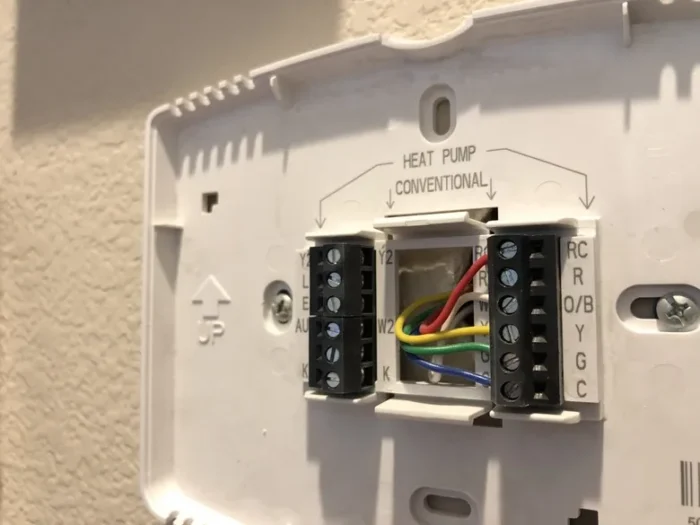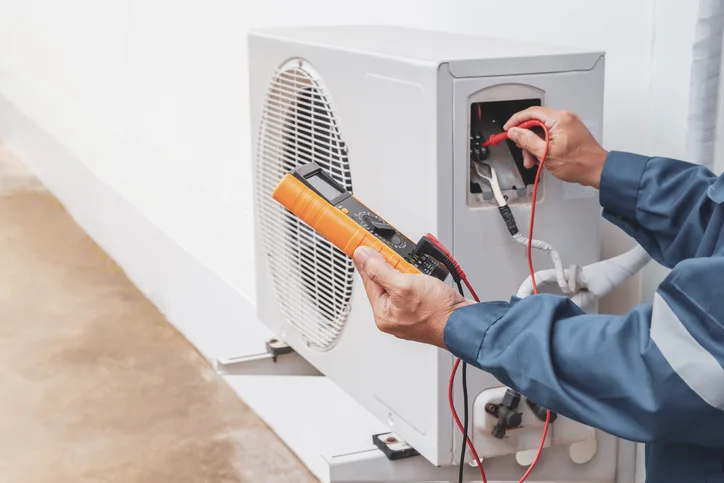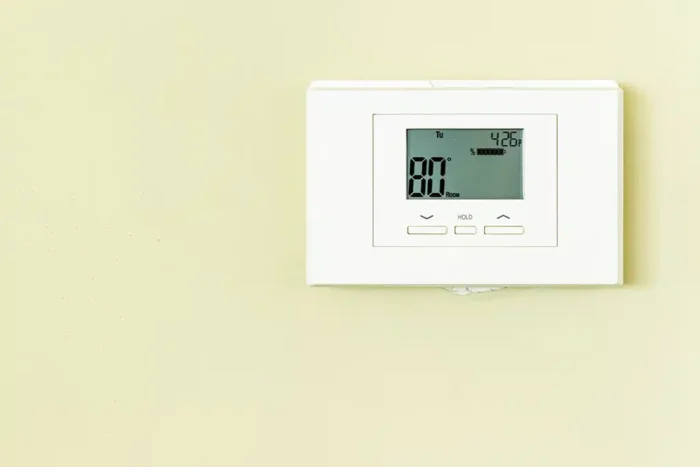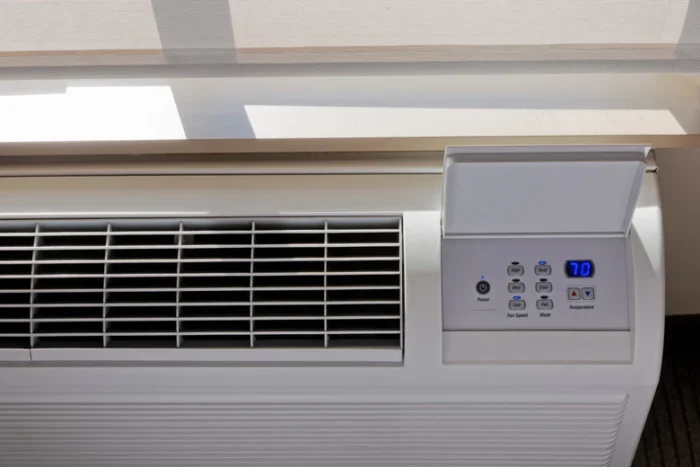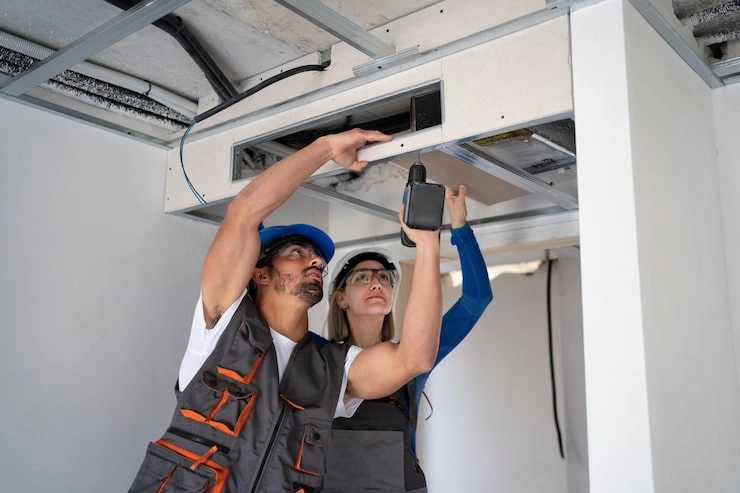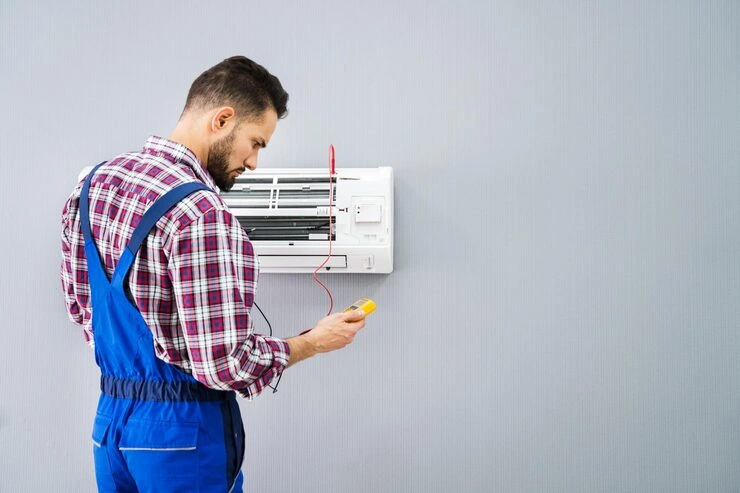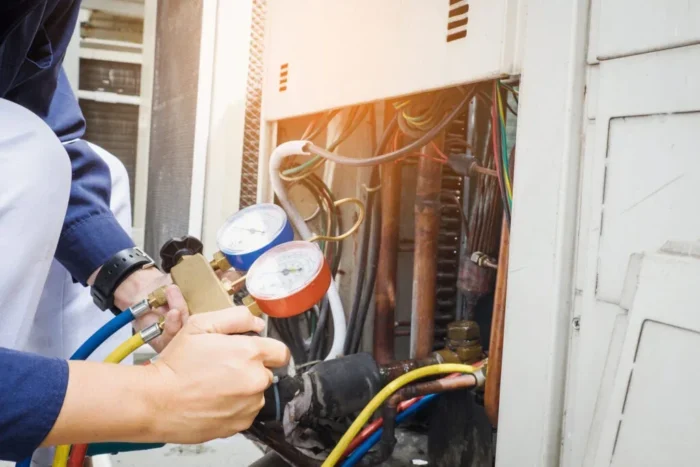A thermostat is a small but essential device that controls your home’s heating and cooling system. It acts as the brain of your HVAC setup, letting you set and maintain comfortable indoor temperatures. Whether it’s a manual or smart model, understanding how it works helps you manage comfort and energy use more effectively.
When it comes to thermostat installation or troubleshooting, knowing the wiring is just as important as understanding the device. Among all wires, the most commonly misunderstood is the blue wire, often called the “C-wire.” So, what is the blue wire on a thermostat? It’s the common wire that provides continuous power, especially for smart thermostats, ensuring smooth operation and efficient HVAC performance.
What is a Thermostat?
A thermostat is a device that automatically regulates your home’s temperature by controlling heating and cooling systems. It maintains your desired comfort level while helping conserve energy.
How It Works
A thermostat contains temperature sensors that continuously monitor the room temperature. When the temperature deviates from your set point, it signals your heating or cooling system to turn on or off automatically. This keeps your indoor climate consistent without manual adjustments.
Types of Thermostats
Manual Thermostats are the simplest option, featuring a basic dial or slider. You set your desired temperature manually, and the thermostat maintains it until you change it again. They’re affordable and reliable but lack advanced features.
Programmable Thermostats let you create temperature schedules for different times and days. For example, you can program lower temperatures during work hours and have the system warm your home before you return. This automation reduces energy waste and lowers utility bills.
Smart Thermostats are the most advanced option, offering Wi-Fi connectivity and smartphone control. They learn your habits over time and adjust automatically for optimal comfort and efficiency. Features include remote access, energy reports, voice assistant integration, and geofencing. Popular brands include Nest, Ecobee, and Honeywell Home. Though pricier initially, they often pay for themselves through energy savings.
How Many Wires Does a Thermostat Have?
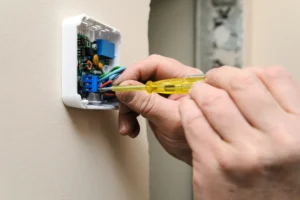
The number of wires in your thermostat depends on your heating and cooling setup. Most homes have anywhere from 2 to 8 wires, but the most common configurations are 4-wire, 5-wire, and sometimes simpler 2-wire systems.
Standard Wiring Configurations
2-Wire Systems are the most basic setup, typically found in older homes with just heating or just cooling (but not both). These systems only need two wires to function and usually control a basic furnace or boiler.
4-Wire Systems are common in homes with both heating and cooling. These four wires handle power, heating, cooling, and fan control, giving you complete control over your HVAC system.
5-Wire Systems include everything a 4-wire system has, plus an additional wire (usually the C wire) that provides constant power. This extra wire has become increasingly important with modern thermostats, especially smart models that need continuous power to stay connected to Wi-Fi and run their displays.
What Each Wire Does
Red Wire (R Wire) brings power from your HVAC system to the thermostat. Think of it as the main power line that makes everything else work. Some systems have two red wires: Rc for cooling and Rh for heating.
White Wire (W Wire) controls your heating system. When you turn up the heat on your thermostat, this wire tells your furnace or boiler to kick on and start warming your home.
Yellow Wire (Y Wire) handles your air conditioning. When the temperature rises above your setting, this wire signals your AC unit to start cooling things down.
Green Wire (G Wire) controls the fan in your HVAC system. This lets you run just the fan to circulate air without heating or cooling, which is great for improving air quality or evening out temperatures between rooms.
Blue or C Wire (Common Wire) provides a continuous power supply and completes the electrical circuit. The blue wire in thermostat installations is crucial for smart thermostats because they need constant power to maintain their Wi-Fi connection, touchscreen display, and learning features. If you’re upgrading to a smart thermostat and don’t have a blue wire on a thermostat connection, you might need to run a new wire or use an adapter kit.
Quick Reference
| Wire Color | Letter | What It Does |
| Red | R | Main power supply |
| White | W | Turns on heating |
| Yellow | Y | Turns on cooling |
| Green | G | Controls the fan |
| Blue | C | Constant power (especially for smart thermostats) |
Keep in mind that wire colors can sometimes vary depending on who installed your system, but these are the standard colors you’ll find in most homes. If you’re ever unsure about your wiring, it’s best to take a photo before disconnecting anything or call an HVAC professional for help.
You may read Why Does My AC Line Keep Freezing?
What is a Thermostat’s Blue Wire and What is It Used For?
The thermostat blue wire, commonly called the C-wire or common wire, provides a continuous flow of power to your thermostat. Unlike other wires that only send signals when heating or cooling is needed, the blue wire in thermostat systems works constantly in the background, completing the electrical circuit between your HVAC control board and the thermostat.
What Does the Blue Wire Do?
Maintains Thermostat Memory and Display
The thermostat blue wire keeps your settings and schedules saved at all times. It powers the digital display and ensures your thermostat doesn’t lose its programming when the heating or cooling system isn’t running. This constant power keeps the internal clock accurate and your preferences intact.
Powers Wi-Fi and Smart Features
Smart thermostats need much more power than basic models. They’re constantly connected to Wi-Fi, running processors that learn your habits, checking weather updates, and waiting for commands from your phone. The blue wire in thermostat installations provides the steady electricity these advanced features demand. Without it, most smart thermostats won’t function properly.
Stabilizes Power Flow
The common wire creates a stable electrical pathway that prevents power fluctuations. This keeps your thermostat from malfunctioning, resetting randomly, or behaving unpredictably. It’s similar to a ground wire in a standard outlet—it completes the circuit and ensures everything runs smoothly.
Not All Systems Have a Blue Wire
Many older homes don’t include a C-wire. Houses built before smart thermostats became popular often have just 4 wires (red, white, yellow, and green). These basic setups worked fine for simple thermostats that ran on batteries.
If your current thermostat uses batteries and you want to upgrade to a smart model, you probably don’t have a thermostat blue wire available. You’ll need to either run a new wire from your HVAC system, install a C-wire adapter kit, or choose a smart thermostat designed to work without a common wire.
Blue Wire vs. Black Wire
While blue is the standard color for the common wire, some HVAC brands use a black wire instead. Both do the exact same job providing continuous power. The color difference depends on the manufacturer or what was available during installation.
Always check the terminal labels rather than just wire colors. The common wire connects to the “C” terminal on both your thermostat and HVAC control board, whether it’s blue, black, or even brown. If you’re unsure about your wiring, check your system’s manual or call an HVAC professional before installing a new thermostat.
What Happens if the Blue Wire is Not Connected?
If your thermostat blue wire isn’t connected or your system doesn’t have one you’ll experience several problems, especially with smart thermostats that need constant power.
Common Symptoms of a Missing Blue Wire
Without a connected blue wire, your thermostat display may not turn on, frequently lose Wi-Fi connection, or reset randomly and erase settings. Your heating and cooling system might also cycle on and off erratically or stop responding to commands.
Thermostat Display Not Turning On
Without a C-wire, many digital and smart thermostats won’t light up at all. The display might flicker briefly or stay completely dark. Some thermostats try to draw power from other wires, but this isn’t reliable and creates additional problems.
Wi-Fi Connection Issues
Smart thermostats need steady power to stay connected. Without a blue wire, your thermostat might constantly disconnect from Wi-Fi, require frequent reboots, or fail to communicate with your smartphone app. You could find yourself reconnecting it several times a day.
Random Resets
A thermostat without adequate power can reset unexpectedly, erasing your schedules and temperature settings. You might come home to an uncomfortable house because your thermostat forgot its programming.
System Malfunctions
Sometimes a missing C-wire causes your heating or cooling to short-cycle (turn on and off rapidly) or stop responding to commands. This happens because the thermostat lacks enough power to send proper signals to your HVAC equipment.
How to Check Your Wiring
Remove your thermostat from the wall and look at the wires. Check if there’s a wire connected to the “C” terminal. If not, look inside the wall opening the blue wire might be tucked inside unused.
Also check your HVAC control board (inside your furnace or air handler). See if there’s an unused blue or black wire on the “C” terminal there. If the wire exists at the control board but not at the thermostat, you may just need to connect it.
When to Call an HVAC Professional
If you’re confident with low-voltage wiring, you can connect the blue wire after turning off the breaker. If not, contact Hutchinson Heating and Air. Our technicians can install a new C-wire, add an adapter, or recommend a compatible thermostat ensuring safe, reliable, and damage-free operation.
Conclusion
In summary, the blue wire also known as the common (C) wire supplies continuous power to your modern thermostat, helping it function efficiently and reliably. Correctly installing this wire ensures your HVAC system delivers consistent heating and cooling performance year-round.
Need help identifying or connecting your thermostat wires? Contact Hutchinson Heating and Air for safe, reliable thermostat and HVAC services in Murrieta and Temecula, CA today!
FAQs
1. What is the blue wire on a thermostat?
The blue wire is the C-wire (common wire) that provides continuous power to your thermostat. It completes the electrical circuit between your HVAC system and thermostat, ensuring constant power flow for displays, Wi-Fi connectivity, and smart features.
2. Do I need a blue wire for my thermostat?
It depends on your thermostat type. Basic manual and battery-powered thermostats don’t require a blue wire. However, most smart thermostats and advanced digital models need a C-wire to function properly and maintain their features.
3. Can I install a smart thermostat without a blue wire?
Some smart thermostats can work without a C-wire using battery power or power-stealing technology, but this isn’t ideal. You can also install a C-wire adapter kit that uses your existing wires differently, or have an HVAC technician run a new wire.
4. How do I know if I have a blue wire?
Remove your thermostat from the wall and check the wires connected to it. Look for a wire attached to the terminal labeled “C.” If there’s nothing there, check inside the wall opening the blue wire might be tucked away unused.

